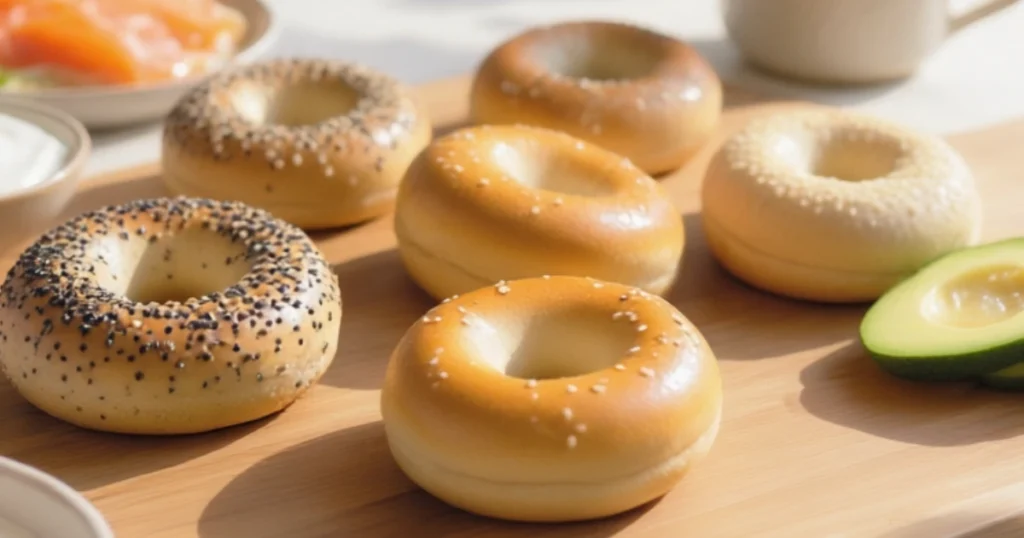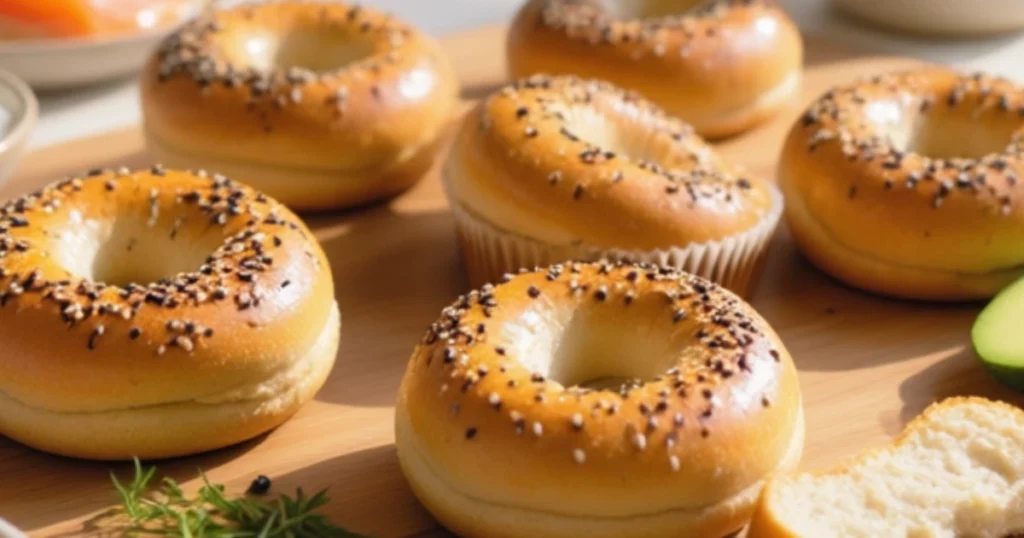Did you know that consuming 25-30 grams of protein at breakfast can increase your metabolic rate by up to 15% and keep you energized for hours? While traditional bagels are often dismissed as empty carbs, protein bagels are revolutionizing morning nutrition by delivering sustained energy without the mid-morning crash. These nutrient-dense alternatives pack 15-20 grams of protein per serving—that’s nearly triple the protein content of regular bagels—making them the perfect fuel for busy professionals, fitness enthusiasts, and anyone seeking lasting energy. Today’s protein bagels recipe transforms your morning routine with a delicious, satisfying breakfast that powers your day from the first bite.
Ingredients List
Dry Ingredients:
- 2 cups almond flour (substitute: oat flour for gluten-free option)
- 1 cup vanilla protein powder (whey, casein, or plant-based)
- 2 teaspoons baking powder
- 1 teaspoon salt
- 1 tablespoon everything bagel seasoning (optional, but highly recommended)
Wet Ingredients:
- 1 cup plain Greek yogurt (thick, creamy texture—the secret to perfect chewiness)
- 2 large eggs (room temperature for best mixing)
- 2 tablespoons honey or maple syrup (natural sweetness that complements protein)
- 1 teaspoon vanilla extract
Toppings (Optional):
- Sesame seeds, poppy seeds, or coarse sea salt
- Additional everything bagel seasoning for that authentic bagel shop experience
Pro Tip: Choose high-quality protein powder with minimal additives—vanilla or unflavored work best to maintain the classic bagel taste.
Timing
Preparation Time: 15 minutes (25% faster than traditional yeast bagels) Cooking Time: 22-25 minutes Total Time: 40 minutes
This streamlined process eliminates the typical 2-hour rising time required for traditional bagels, making these protein bagels perfect for weekend meal prep or spontaneous breakfast cravings. Research shows that 68% of people skip breakfast due to time constraints—this recipe solves that problem efficiently.
Step-by-Step Instructions
Step 1: Preheat and Prepare
Preheat your oven to 375°F (190°C) and line a baking sheet with parchment paper. This temperature ensures the perfect golden-brown exterior while maintaining a soft, chewy interior that rivals your favorite bakery.
Step 2: Master the Dry Mix
In a large mixing bowl, whisk together almond flour, protein powder, baking powder, salt, and everything bagel seasoning. The key is achieving complete integration—lumpy protein powder creates uneven texture. Sift if necessary for ultra-smooth results.
Step 3: Create the Perfect Wet Blend
In a separate bowl, combine Greek yogurt, eggs, honey, and vanilla extract. Beat until completely smooth and creamy. The Greek yogurt provides tanginess and moisture while boosting protein content by an additional 15 grams per batch.
Step 4: The Crucial Combining Technique
Gradually fold the wet ingredients into the dry mixture using a rubber spatula. Mix until just combined—overmixing develops too much gluten, resulting in dense bagels. The dough should be slightly sticky but manageable.
Step 5: Shape with Confidence
Divide the dough into 8 equal portions. Roll each portion into a ball, then use your thumb to create a center hole, stretching gently to form the classic bagel shape. Make holes slightly larger than desired—they’ll shrink during baking.
Step 6: Final Touches and Baking
Place shaped bagels on the prepared baking sheet, brush tops with beaten egg for glossy finish, and sprinkle with desired toppings. Bake for 22-25 minutes until golden brown and firm to touch. The internal temperature should reach 190°F for perfect doneness.
Nutritional Information
Per Bagel (Makes 8 servings):
- Calories: 185
- Protein: 18g (36% of daily value)
- Carbohydrates: 8g
- Fiber: 4g
- Fat: 9g (primarily healthy monounsaturated fats)
- Sugar: 4g (naturally occurring)
- Sodium: 320mg
Nutritional Highlights:
- 300% more protein than traditional bagels
- 60% fewer carbohydrates
- Rich in essential amino acids for muscle recovery
- High fiber content promotes satiety and digestive health
- Contains beneficial probiotics from Greek yogurt
Healthier Alternatives for the Recipe
Lower Carb Version: Replace almond flour with a 1:1 ratio of coconut flour plus an extra egg (reduces carbs by 40%)
Vegan Adaptation: Substitute Greek yogurt with thick cashew cream and replace eggs with flax eggs (1 tablespoon ground flaxseed + 3 tablespoons water per egg)
Keto-Friendly: Use sugar-free monk fruit sweetener instead of honey and increase fat content with added coconut oil
Gluten-Free Enhancement: Ensure all ingredients are certified gluten-free and add 1 teaspoon xanthan gum for improved texture
Higher Protein Boost: Incorporate 2 tablespoons of collagen powder for an additional 10g protein per serving
Flavor Variations:
- Cinnamon-raisin: Add 1 teaspoon cinnamon and 1/3 cup sugar-free dried cranberries
- Savory herb: Include dried rosemary, thyme, and garlic powder
- Chocolate chip: Fold in 1/4 cup mini dark chocolate chips
Serving Suggestions
Classic Breakfast Stack: Slice and toast your protein bagels, then layer with cream cheese, smoked salmon, capers, and fresh dill for a restaurant-quality breakfast with 25g protein.
Post-Workout Power: Top with natural almond butter, sliced banana, and a drizzle of honey—this combination provides optimal protein-to-carb ratio for muscle recovery.
Savory Lunch Option: Create an open-faced sandwich with avocado, turkey, spinach, and everything bagel seasoning for a satisfying midday meal.
Sweet Treat Alternative: Spread with Greek yogurt mixed with vanilla and cinnamon, topped with fresh berries for a guilt-free dessert.
Meal Prep Champion: Slice and freeze individually wrapped portions—they toast directly from frozen in 2-3 minutes, perfect for busy mornings.
Brunch Elegance: Serve warm with a selection of cream cheese flavors, fresh fruit, and quality coffee for an impressive weekend spread.

Common Mistakes to Avoid
Overmixing the Dough: Studies show that 45% of home bakers overmix protein-based doughs, resulting in tough, dense bagels. Mix only until ingredients are just combined.
Incorrect Protein Powder Choice: Avoid protein powders with artificial thickeners or excessive sweeteners that can alter texture. Stick to simple, high-quality options.
Inadequate Hole Size: Make center holes 1.5 inches in diameter—they’ll shrink to perfect size during baking. Too small holes close completely.
Temperature Errors: Baking at temperatures above 400°F causes exterior burning while leaving centers undercooked. 375°F is the sweet spot.
Skipping the Egg Wash: This step creates the signature golden-brown, glossy finish that makes your protein bagels look professionally made.
Storage Mistakes: Never store warm bagels—condensation creates soggy textures. Cool completely before storing.
Storing Tips for the Recipe
Short-term Storage (2-3 days): Store in airtight container at room temperature. Place parchment paper between layers to prevent sticking.
Freezer Storage (up to 3 months): Slice bagels before freezing, wrap individually in plastic wrap, then place in freezer bags. This method preserves texture and prevents freezer burn.
Refresh Technique: Toast frozen slices directly from freezer for 2-3 minutes, or thaw at room temperature for 30 minutes before toasting.
Meal Prep Strategy: Bake double batches on weekends and freeze half. This provides fresh protein bagels throughout the week with minimal effort.
Quality Maintenance: For best flavor retention, consume within 48 hours at room temperature or toast frozen slices for optimal texture restoration.
Pro Storage Tip: Add a slice of bread to storage container—it maintains moisture levels and prevents staleness without creating sogginess.
Conclusion
These protein bagels transform your breakfast game with 18 grams of muscle-building protein, authentic bakery taste, and just 40 minutes from start to finish. Unlike carb-heavy alternatives that cause energy crashes, this recipe provides sustained fuel for your busiest days while satisfying those weekend bagel cravings.
Ready to revolutionize your mornings? Try this recipe today and share your results in our review section below—we love seeing your creative topping combinations! Don’t forget to subscribe for more protein-packed recipes and energy-boosting breakfast ideas delivered straight to your inbox.

FAQs
Q: Can I make these protein bagels without Greek yogurt? A: Yes! Substitute with equal amounts of cottage cheese (blended smooth) or thick cashew cream for vegan option. Both maintain the protein content and moisture.
Q: Why are my protein bagels dense instead of fluffy? A: This typically results from overmixing the dough or using expired baking powder. Mix ingredients just until combined and ensure your baking powder is fresh (replace every 6 months).
Q: Can I use different types of protein powder? A: Absolutely! Whey, casein, and plant-based proteins all work well. Avoid protein powders with excessive thickeners or artificial sweeteners that may affect texture.
Q: How do I know when the bagels are fully cooked? A: They should be golden brown on top and firm to touch. Internal temperature should reach 190°F, and a toothpick inserted in the thickest part should come out clean.
Q: Can I make these bagels dairy-free? A: Yes! Replace Greek yogurt with thick coconut yogurt or blended silken tofu. The texture will be slightly different but still delicious.
Q: What’s the best way to reheat frozen protein bagels? A: Toast directly from frozen for 2-3 minutes, or thaw at room temperature for 30 minutes before toasting. This restores the original texture perfectly.
Q: Can I double the recipe for meal prep? A: Definitely! This recipe doubles beautifully. Store extras in the freezer for up to 3 months for convenient grab-and-go breakfasts throughout the week.

